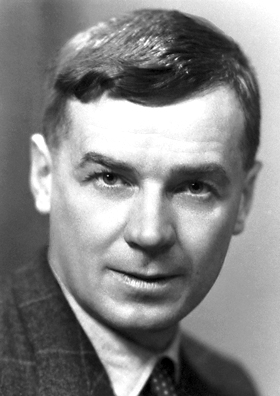Richard Laurence Millington Synge facts for kids
Quick facts for kids
Richard Laurence Millington Synge
|
|
|---|---|
 |
|
| Born | 28 October 1914 Liverpool, England
|
| Died | 18 August 1994 (aged 79) Norwich, England
|
| Alma mater | Winchester College Trinity College, Cambridge |
| Known for | chromatography |
| Awards | Nobel Prize in Chemistry (1952) John Price Wetherill Medal (1959) |
| Scientific career | |
| Fields | biochemist |
| Influences | John H. Humphrey |
Richard Laurence Millington Synge was a British biochemist. A biochemist studies the chemistry of living things. He won the 1952 Nobel Prize in Chemistry. He shared this award with Archer Martin. They won for inventing a special method called partition chromatography. This method helps separate different chemicals in a mixture.
About Richard Synge
Richard Synge was born on October 28, 1914. His birthplace was West Kirby, England. His father, Lawrence Millington Synge, worked as a stockbroker.
He went to school at Old Hall and Winchester College. Later, he studied Chemistry at Trinity College, Cambridge University.
Synge spent his whole career doing scientific research. He worked at several important institutes. These included the Wool Industries Research Association in Leeds. He also worked at the Lister Institute in London. Later, he moved to the Rowett Research Institute in Aberdeen. Finally, he worked at the Food Research Institute in Norwich.
Developing Chromatography
While working in Leeds, Richard Synge teamed up with Archer Martin. Together, they created partition chromatography. This new method was a big step forward in chemistry. It made it much easier to separate mixtures of similar chemicals. This invention changed how scientists analyzed many substances.
Between 1942 and 1948, Synge also studied small protein pieces called peptides. He focused on peptides from a group of proteins called gramicidin. His work was very important. It helped another scientist, Frederick Sanger, figure out the structure of insulin. Insulin is a vital hormone in our bodies.
In 1950, Synge became a Fellow of the Royal Society. This is a very high honor for scientists in the UK. They recognized him for his work in biochemistry. They noted his use of a method to separate amino acids. They also praised his work with Archer Martin on partition chromatography. This method helped them understand proteins better.
In 1963, he also became a Fellow of the Royal Society of Edinburgh. From 1968 to 1984, he was an honorary Professor. He taught Biological Sciences at the University of East Anglia. He also received honorary doctorates from two universities. These were the University of East Anglia and Uppsala University in Sweden.
Personal Life
In 1943, Richard Synge married Ann Davies Stephen. Ann was the daughter of a psychologist, Karin Stephen. Her father, Adrian Stephen, was a psychoanalyst. Ann's sister, Judith, was married to an artist named Nigel Henderson.
See also
 In Spanish: Richard L. M. Synge para niños
In Spanish: Richard L. M. Synge para niños
Images for kids


